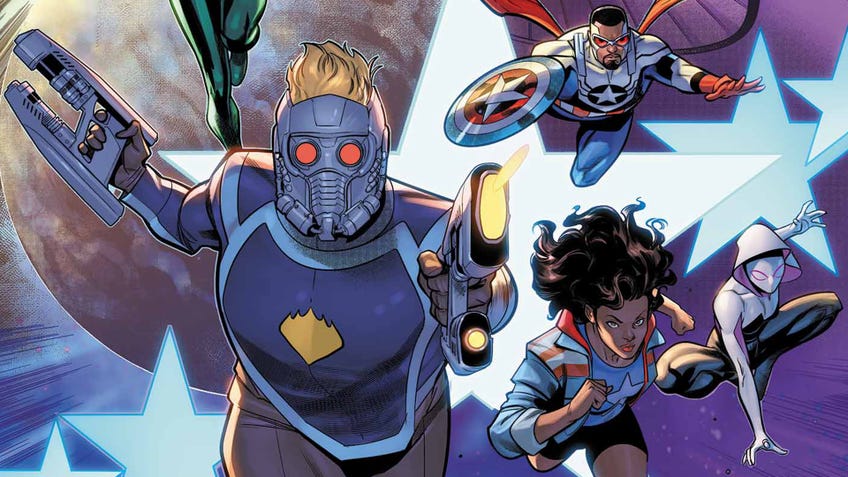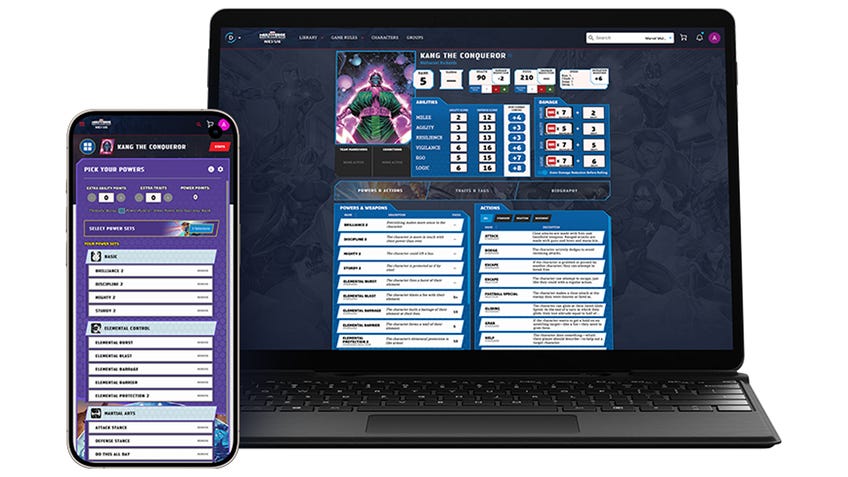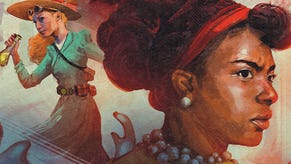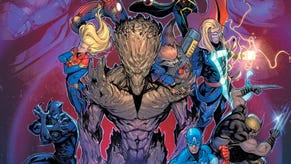Marvel Multiverse creators on staying true to the comics, going behind the mask of superheroes and making ‘Avengers moments’ in the tabletop RPG
“We focused on making the game feel like a blockbuster Marvel event.”
2023 marked the beginning of a new era for the Marvel Cinematic Universe, laying down the groundwork for the fifth phase of the sprawling franchise’s ever-evolving superhero roster and converging storylines. Last year wasn’t only a notable year for Marvel on-screen, but on the tabletop too, as the comic-book giant fully launched its latest tabletop RPG (and first in over a decade): the Marvel Multiverse Role-Playing Game.
In keeping with the years-long storytelling of its big-screen counterparts, Marvel Multiverse took its time to come to the table, with the game first announced in 2021 before a playtest set of rules released the following spring. Over a year later, the RPG’s core rulebook solidified its original d616 gameplay system and playable take on classic Marvel superhero stories last summer.
With the core rulebook now in players hands, alongside an adventure collection inspired by baddie Kang, and plans to delve into the worlds of the X-Men and the Spider-Verse, we spoke to Marvel Multiverse game designer Matt Forbeck and Carlos “CJ” Cervantes Jr., Marvel project lead and producer for the RPG, about the game’s journey so far, staying faithful to the spirit of the comics and what comes next.
RPGs are about creating your own character, while Marvel has a roster of very familiar and popular characters. How did you find the balance between allowing players to create their own heroes - rather than just Avengers by another name - while also having the Multiverse RPG feel faithful to the Marvel superheroes we know?
Forbeck: The game features a full-featured character-creation system that allows players to come up with whatever kind of character they want and play them however they like. That said, this is not a generic game that any kind of character fits into. It’s a Marvel game, so the powers and mechanics all lean heavily into that. You can come up with some amazing original characters, but there’s always going to be something Marvel about them.
CJ: We wanted to create a game where players truly felt like they were playing within their own sandbox, or Multiverse, at the table. Giving players the tools they needed to create their own dynamic heroes wasn’t enough, though. In order to make the game balanced, we built every single Marvel character using the same exact character creation tools. This way, the Marvel heroes never felt unattainable. Your own heroes can save the day right alongside Captain America!
We wanted to create a game where players truly felt like they were playing within their own sandbox, or Multiverse, at the table.
How does designing an RPG about superhero stories - specifically those seen in Marvel comics - differ to designing games set in fantasy or sci-fi worlds? How did you make it “feel” like a superhero story?
Forbeck: We focused on making the game feel like a blockbuster Marvel event. This isn’t a game about delving into dungeons or fighting your way through a futuristic forever war. It’s made for great Marvel drama coupled with bombastic superhero fights.
The d616 dice system really helps with that. You get something wild happening on one out of six rolls, and you can juice things to make that happen even more often. You actually hear lots of triumphant cheers at the table.
CJ: By nature, a Level 1 adventurer is going to feel vastly different than a Rank 1 superhero. Tasks that seem challenging for someone with a short sword or bow and arrow are going to feel like a breeze for someone with super-strength who can fly at the speed of light. This however allows us to get creative with scale and problem-solving. Need to get into a building? Fly to the top or break through the wall. Need to save hostages? Phase them through the floor and out of harm’s way. We’ve seen players do some incredibly “super” things just by thinking outside of the box.

You ran a public playtest for the game ahead of release. What were the key things that came out of that?
Forbeck: While the responses for the playtest version of the game were overwhelmingly positive, they also highlighted a number of areas of the game that could be improved. We took full advantage of that and stripped the game down to the studs to rebuild it better, sleeker and more fun than ever. It plays a lot easier now, and the math that’s involved is far more intuitive.
We slimmed the ranks in the game from 25 down to six. We eliminated archetypes entirely. We came up with an all-in-one-roll system for hits and damage in combat. It really sings.
CJ: At the end of the day, we wanted to build a game that the community really loved. We were thrilled with the feedback response, which ultimately helped us develop a game that fit exactly what fans wanted.
What was the importance of using the original d616 system, versus another framework? (Did the wink-wink name come first, or the system?)
Forbeck: The name affected the number that we chose as the special number on the Marvel die. (It’s the 1, which counts as a 6 and can cause special effects.) However, we started out wanting to use d6s because just about everyone can find them in their house by raiding old board games.
Also, we wanted to set the mechanics on a bell curve rather than a flat curve, which is what you get from adding multiple dice rather than rolling a single one. It makes the dice rolls less swingy, and that makes figuring out likely results a bit easier for most people to manage intuitively.
CJ: We wanted the game to be accessible, yet familiar, to as many people as possible. Marvel is a massive brand with an extremely large fan base. While this game might be many people’s first, we recognise that it could be someone else’s tenth! Using d6s and a single-roll system allowed us to create something that felt fresh to veterans yet easy to pick up for newbies.

Marvel Multiverse is far from the first superhero RPG. How did you ensure that it felt distinctly “Marvel” for fans looking to play it over other superhero games?
Forbeck: Beyond the things like the acrostic for the abilities spelling MARVEL and the name of the d616 system, we concentrated on making the powers and origins feel like they sprang right from the pages of Marvel’s comics. We also paid homage to older versions of the game by using things like Karma points, which you can use to reroll dice or rally in the middle of a fight.
CJ: I’d say being able to play as Spider-Man feels distinctly Marvel! Jokes aside, the core rulebook has over 120 pre-generated Marvel Characters that you can pick up and play on day one. Every character is someone’s favourite, so we wanted to make sure we covered all of our bases by including characters from Captain America to Blade, all the way to Blue Marvel. We even added a section called “Creating a Character the Marvel Way” to ensure that players remembered to think about the person behind the mask when building their own supers. Demiplane does an incredible job of capturing this in their Character Creations tools on the Marvel Multiverse RPG Nexus.
We concentrated on making the powers and origins feel like they sprang right from the pages of Marvel’s comics.
What’s your favourite detail from the Marvel Universe that you managed to reflect in the Multiverse RPG?
Forbeck: How Marvel’s sliding time works. You can get the full explanation in the book, but the short version is that four years in the real world is roughly a year in the Marvel Multiverse - and that time is anchored to the present. That means that the Fantastic Four’s fateful maiden voyage into space happened in 2008 or so, rather than in 1961.
CJ: Team Maneuvers! We’ve all seen those massive, epic superhero team-up moments, where the Avengers band together to make one final stand to put an end to the big bad. We added mechanical rules to the game that let players recreate that by rewarding them for working together during combat. It’s one aspect of the game that’s unique to our system and creates awesome, fun moments at the table.

What’s on your wish list to bring to the game, whether specific inspirations from Marvel or broader game design ideas?
Forbeck: I don’t have a wish list as much as a wish roll of paper that bounds down the stairs and into the street. There’s so much to cover in the Marvel Multiverse, spanning more than eighty years of history. We’re planning to build out not just the profiles and sourcebook material, but also the mechanics. We didn’t want to get too heavy into equipment or vehicles, for instance, in the main book, as we thought that would alter the focus of the game a bit, but we want to give players all sorts of options for including things like that in the future.
CJ: I’ve seen Matt’s wish roll - rumour has it the roll goes on for miles, and it’s only growing! Equipment is the number-one requested feature/mechanic that we’re working on for the game. As Matt pointed out, we didn’t want this to be the focus of the game. A game about superheroes and powers can suddenly turn into a game about loot and equipment. While there are certainly some famous Marvel artefacts that we’re excited to explore, we wanted the core game to focus more on the characters.
What else do you have planned for the Marvel Multiverse RPG?
Forbeck: Our first adventure book - a 256-page hardback called The Cataclysm of Kang - just came out. That has six adventures in it, one for each rank in the game, taking you all the way from origin stories to saving the entire Multiverse.
We’re currently working on the X-Men Expansion, which is due out next summer, and we’ll have a Spider-Verse Expansion out later in the year after that. Plus, there’s lots more we haven’t announced yet but are tinkering with.
CJ: As Matt said, stay tuned for future announcements. I’d say more, but I don’t want S.H.I.E.L.D. to confiscate my laptop.





